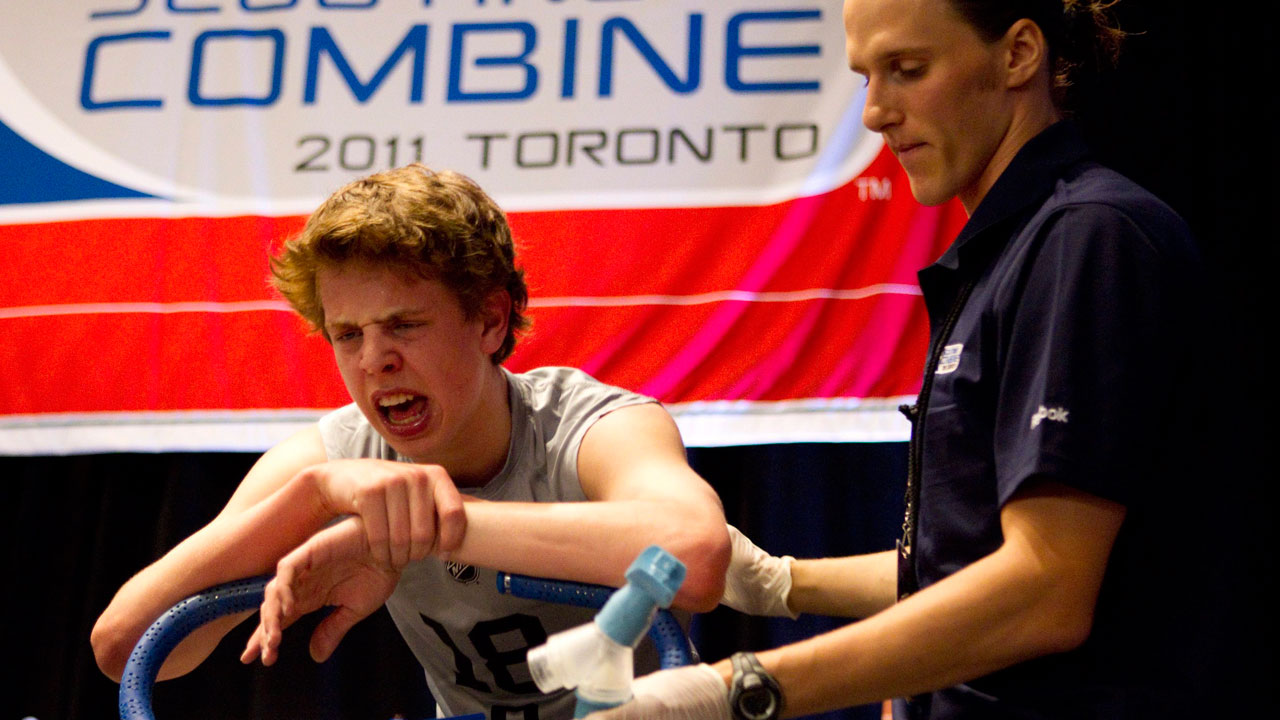When NHL Central Scouting Service launched its combine in 1994, it was not a media event. In fact, it flew completely under the radar. Not one word in the papers, nothing on the tube.
And that’s how it went for its first four or five instalments.
I crashed one back in the late 90s and wondered exactly what the h— was going on. I couldn’t imagine that most hockey fans could be the least bit interested in watching it, but I was fascinated.
It became appointment viewing for me over the following springs, though I couldn’t imagine that it would make any sort of television programming — the players hit the stations in a dark, cramped, virtually airless basement meeting room at a hotel out by Toronto’s airport. Mostly, I thought it was an opportunity to buttonhole scouts and execs and take some strange satisfaction in watching elite athletes pushed to the brink of failure. And the prospects were always captive quotes — it’s impossible to dodge reporters when they’re too dizzy to stand up. And as far as media management and the like, well, there were no credentials or crowd management. Anyone could have wandered in off the street.
STANLEY CUP PLAYOFFS: | Broadcast Schedule
Rogers NHL GameCentre LIVE | Stanley Cup Playoffs Fantasy Hockey
New Sportsnet app: iTunes | Google Play
I guess I should have seen the potential of the combine as a media event when Alexander Ovechkin showed up at the combine in 2004. The combine was an opportunity to see the projected No. 1 who had been seen at a couple of world juniors and little else. Ovechkin, as is his wont, put on a show.
The next spring, the combine wasn’t quite a show but it was an episode of the series that was the Season with Sidney, a series that played out with the NHL shuttered by the lockout and cancelled season.
Flash forward ten years: Now the combine is not just an event, but someone is actually paying to host it. A few years back it moved out of the basement and into a convention hall out in Toronto’s burbs, but still, that the Buffalo Sabres are hosting the testing at the First Niagara … never saw it coming. Though, it proves that hockey’s base audience has an appetite for the game that is insatiable.
Really, I think some fans would watch two cockroaches playing hockey.
Back to 1994, though.
In that first session NHL Central Scouting brought in 77 forwards, 49 defencemen and six goaltenders — significantly larger than the Ovechkin and Crosby combine years. It might have been a comment on that season, though, a painfully weak draft class. Central Scouting might have been pulling out the stops trying to find talent, any talent.
That spring Ed Jovanovski went first overall to the Florida Panthers.
In looking at the results, I figured that Jovo, a physical menace in the OHL, would have killed the basic strength portion of that combine testing, the bench press. Jovo was built like a bank vault yet his combine performance didn’t back that up: He managed 11 reps on the bench, one above the average for defenceman and an astonishing 15 fewer than the blueliner who led the field, Brad Symes. Yes, Edmonton Oilers fans, that Brad Symes, a third-round pick that year who never got a sniff in the NHL, played but five games as high as the AHL and was last seen in 1998 with the New Orleans Brass, an ECHL team, not a jazz band.
Some things that we presume to be true, though, might not be true. For instance, we presume that with training advances and an attention to nutrition that borders on the obsessive, players are in significantly better shape on all counts today than they were 20 years ago. And maybe that holds true on aerobic and anaerobic testing (though any improvements might reflect only greater familiarity and practice with the testing apparatuses).

Download Sportsnet magazine now: iOS | Android | Windows
But on at least one very basic test, there really doesn’t seem to be any change at all. At last year’s combine the average body fat for prospects (using the skin fold test) was 9.8, an absolute saw-off with the numbers from 1994. And what makes that even more remarkable was that there were several prospects in ’94 whose body fat measurements were absolutely off the scale and should have pushed the average up, notably Terry Marchant and Martin Belanger at almost 17 per cent. Even longtime NHLers like Ethan Moreau, Radek Bonk and Wayne Primeau were up at 13 per cent.
It looks like those doing summary assessments of players’ overall development were more generous in ’94 than today. In these, the doctors offer two rankings per player, one for upper-body development, the other for lower-body. For all the defenceman only three rankings dipped to below average — and somehow the guy who had two of them, Sheldon Souray, played more than others regarded as musclemen.
It also seems that there wasn’t much sharing of medical info in ’94. The medical assessments of players only flagged six of the skaters for any sort of significant injury — impossible to imagine.
It wouldn’t be fair to try to put VO2, Wingate, Mean power and a lot of the other combine work from 1994 up against 2015 simply because the hardware and software will have changed significantly. On those lowest-tech stuff though, it seems that the performances are strikingly similar. And one thing true then remains true today: A dismal combine performance doesn’t kill you and workout warriors can wash out.


